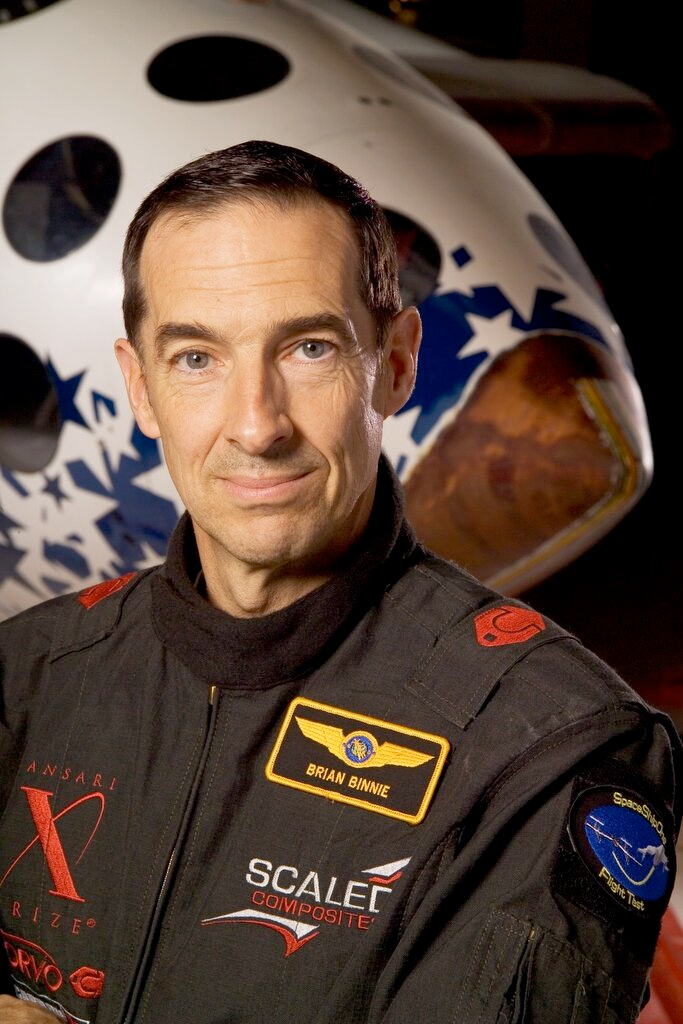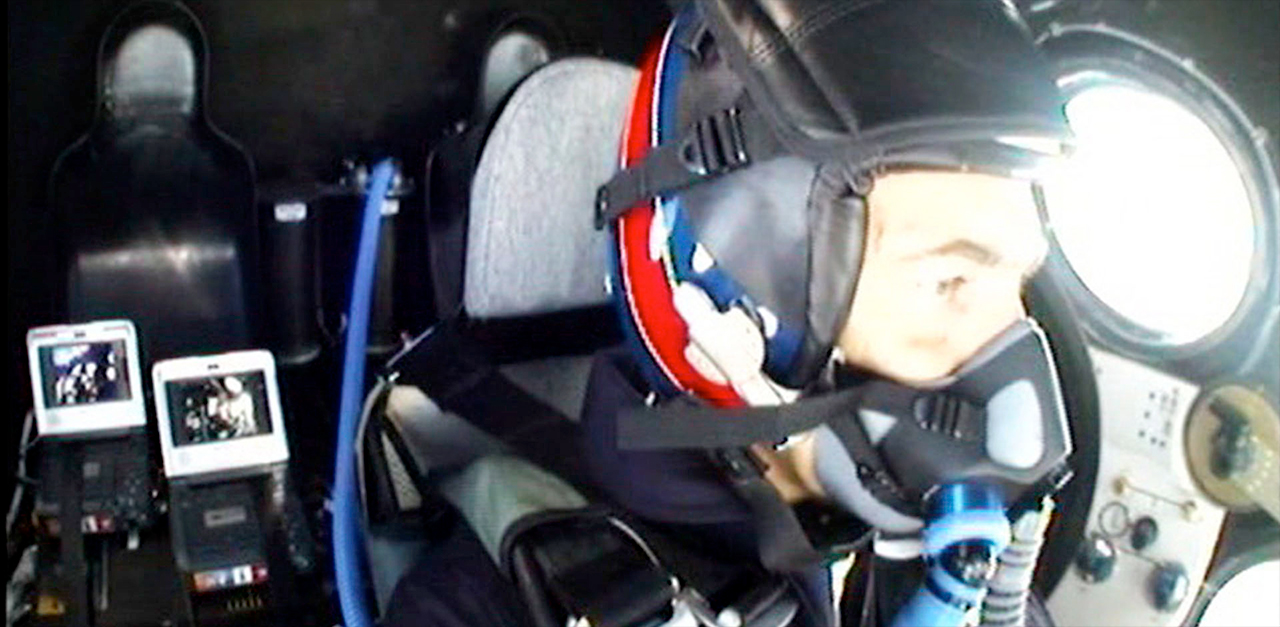Brian Binnie, SpaceShipOne test pilot who won XPrize, dies at 69
Binnie may have been the last person to launch into space alone.

Brian Binnie, who in 2004 became the second person in history to pilot a private craft into space, has died at the age of 69.
Binnie's death on Thursday (Sept. 15) was confirmed by his family on Sunday. The cause of death was not stated.
"With overwhelming grief, sadness and sorrow we announce the passing of our beloved Brian," his family members posted on Binnie's Facebook page. "We kindly ask for privacy during this time for our family to grieve the loss of our husband, father, brother and friend."
Arrangements are being made for Binnie to be laid to rest at Arlington National Cemetery in Virginia.
As a test pilot for Scaled Composites, the aerospace design firm founded by Burt Rutan (and today owned by Northrop Grumman), Binnie took off on board the SpaceShipOne rocket plane on Oct. 4, 2004. His 24-minute flight reached a peak altitude of 69.6 miles (112 km), surpassing the internationally-recognized von Kármán line separating Earth's atmosphere from outer space and broke the record for a winged-craft set by the X-15 rocket plane in 1963.
Binnie was the 442nd person to fly into space.

"People called it the perfect flight. In leaving the atmosphere, as I kept the motor running to 215,000 feet, the ship had zero roll, pitch [and] yaw rates. It was rock solid and continued on up past the X-15 altitude," Binnie told Space.com in 2021 interview. "It was a wonderful experience."
Get the Space.com Newsletter
Breaking space news, the latest updates on rocket launches, skywatching events and more!
The flight qualified Scaled to win the Ansari XPrize, which offered $10 million to the first privately-built spacecraft to fly twice into space within a two-week period. Binnie's flight followed test pilot Mike Melvill flying the same vehicle to 63.9 miles (102.9 km) on Oct. 29. (Binnie flew the WhiteKnight mothership for that flight.)
Binnie was the last to fly SpaceShipOne, which was donated to the Smithsonian for display at the National Air and Space Museum in Washington, D.C. The vehicle became the basis for Virgin Galactic's larger SpaceShipTwo, which is designed to fly two pilots and up to six paying passengers to space.
"I don't see any single-seat spaceships in the near future. So maybe I am the last guy that has gone to space by himself," said Binnie.
William Brian Binnie was born on April 26, 1953, in West Lafayette, Indiana. From age 5 to his teenage years, though, he lived with his family in Scotland. After returning to the U.S., he earned his bachelor's degree in aerospace engineering and a master's in fluid mechanics and thermodynamics from Brown University in Rhode Island.
Binnie also held a master's degree in mechanical and aerospace engineering, which he earned at Princeton University in New Jersey. It was there that Binnie learned how to fly, first aboard a glider as a member of the school's Soaring Society and then testing experimental designs as a student in Princeton's flight research center.
That experience led him to enlist in the U.S. Navy in 1978. Binnie completed five operational tours, which included 490 arrested landings on aircraft carriers, as well as seeing combat as part of operations Desert Shield, Desert Storm and Southern Watch.
He graduated from the U.S. Naval Test Pilot School in 1988 and served for 13 years as a naval aviator, testing systems for the A-7 Corsair II, A-6 Intruder and the F/A-18 Hornet.
He retired from the Navy with the rank of commander in 1998, having logged more than 4,300 flight hours.

Before joining Scaled in 2000, Binnie worked as a test pilot for Rotary Rocket, proving that the company's Roton vertical take off and landing vehicle could return to Earth under spinning rotors.
"We did what we said we were going to do ... demonstrate control of the vehicle in the landing pattern," Binnie told Space.com.
Prior to his flight into space, Binnie flew SpaceShipOne twice, including its first powered flight on Dec. 17, 2003, the 100th anniversary of the Wright brothers' first powered flight. He also flew on WhiteKnight on 12 joint flights with SpaceShipOne.
After leaving Scaled in 2014, Binnie joined XCOR Aerospace as senior engineer and test pilot, joining former NASA astronaut Rick Searfoss in the development of the company's family of Lynx suborbital vehicles.
For his 2004 suborbital spaceflight, Binnie was awarded Civilian Astronaut Wings by the FAA (Federal Aviation Administration) and was honored by the Gathering of Eagles Foundation. As a member of the team behind SpaceShipOne, Binnie was presented with the Space Achievement Award by the Space Foundation and was a recipient of the National Aeronautic Association's Robert J. Collier Trophy.
In 2006, Binnie appeared in a series of television commercials for Miller Lite beer, appearing as part of the "ancient order of men" as described by actor and narrator Burt Reynolds. In 2009, Binnie became a brand ambassador for Ball Watches.
In 2021, Binnie wrote "The Magic and Menace of SpaceShipOne: A First-Person History of the World's First Commercial Spaceflights" (Nitrosyncretic Press), recounting in 400 pages his experience with the XPRIZE-winning spacecraft.
Binnie is survived by his wife, Bub, and their three children, Justin, Jonathan and Jennifer.
Follow collectSPACE.com on Facebook and on Twitter at @collectSPACE. Copyright 2022 collectSPACE.com. All rights reserved.
Join our Space Forums to keep talking space on the latest missions, night sky and more! And if you have a news tip, correction or comment, let us know at: community@space.com.

Robert Pearlman is a space historian, journalist and the founder and editor of collectSPACE.com, a daily news publication and community devoted to space history with a particular focus on how and where space exploration intersects with pop culture. Pearlman is also a contributing writer for Space.com and co-author of "Space Stations: The Art, Science, and Reality of Working in Space” published by Smithsonian Books in 2018.In 2009, he was inducted into the U.S. Space Camp Hall of Fame in Huntsville, Alabama. In 2021, he was honored by the American Astronautical Society with the Ordway Award for Sustained Excellence in Spaceflight History. In 2023, the National Space Club Florida Committee recognized Pearlman with the Kolcum News and Communications Award for excellence in telling the space story along the Space Coast and throughout the world.










